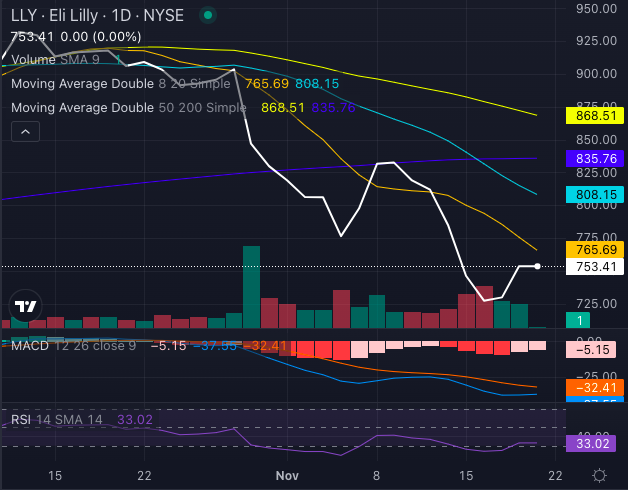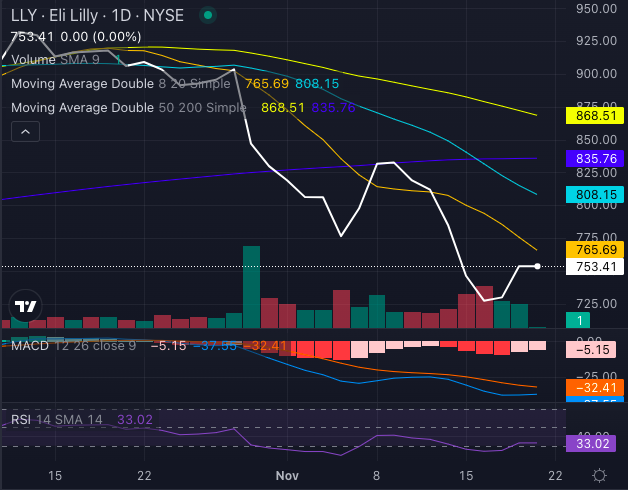Eli Lilly Faces Challenges Amidst Volatile Market Conditions
Stock Overview: Despite a 26.04% increase over the last year, Eli Lilly and Co. LLY has encountered a sharp decline of 17.57% in the past month.

Chart created using Benzinga Pro
The current trading price of Lilly stock stands at $746.94, significantly lower than its summer highs. The company’s strong position in the obesity treatment market faces pressure from bearish market sentiments and political uncertainties.
Could the Recent Selloff Be An Overreaction?
Technical Indicators Signal Caution for LLY Stock
Currently, Lilly stock is trading below its eight-, 20-, and 50-day exponential moving averages, indicating a bearish trend. With a Relative Strength Index (RSI) of 33.02, the stock appears to be on the edge of oversold territory. Additionally, a MACD reading of -37.55 reflects strong downward momentum.
The 200-day simple moving average, which sits at $835.76, further adds to investor concerns, highlighting how far the stock has fallen.
Market Turbulence Fueled by Political Concerns
The recent decline in anti-obesity drugmakers, including Eli Lilly, Novo Nordisk AS NVO and Amgen Inc AMGN, has been largely attributed to fears surrounding the potential appointment of Robert F. Kennedy Jr. as head of the Department of Health and Human Services by President-elect Donald Trump.
His critical views on GLP-1 weight-loss treatments raise concerns over possible restrictions on insurance coverage and pricing. Although the department’s power to enact major changes is limited, investor anxiety remains high.
Are There Opportunities Amidst the Decline?
For those looking for investment opportunities, Eli Lilly’s fundamentals tell a different story. Sales of its drugs, Zepbound and Mounjaro, are expected to reach $18 billion by 2026, which is twice the estimated sales for 2024.
The company’s total revenue forecast suggests a rise to $69 billion by 2026, with earnings potentially exceeding $30 per share, a significant increase from the current $13.26.
With a forward earnings ratio of 33.2 (as per Benzinga Pro data), the stock looks relatively more appealing than its peak ratio of 57.2 in July.
Future Outlook: What Comes Next?
Jim Cramer encapsulates the contrarian view, stating, “This stock is as hated now as it was loved not long ago. I think it’s a buy… enough on the selling.”
Long-term investors might find Eli Lilly’s leadership in the growing obesity drug market a promising growth narrative. The choice between viewing the current selloff as a warning or an opportunity hinges on investor confidence in the company’s fundamentals.
Read Next:
Photo courtesy of Eli Lilly.
Market News and Data brought to you by Benzinga APIs

